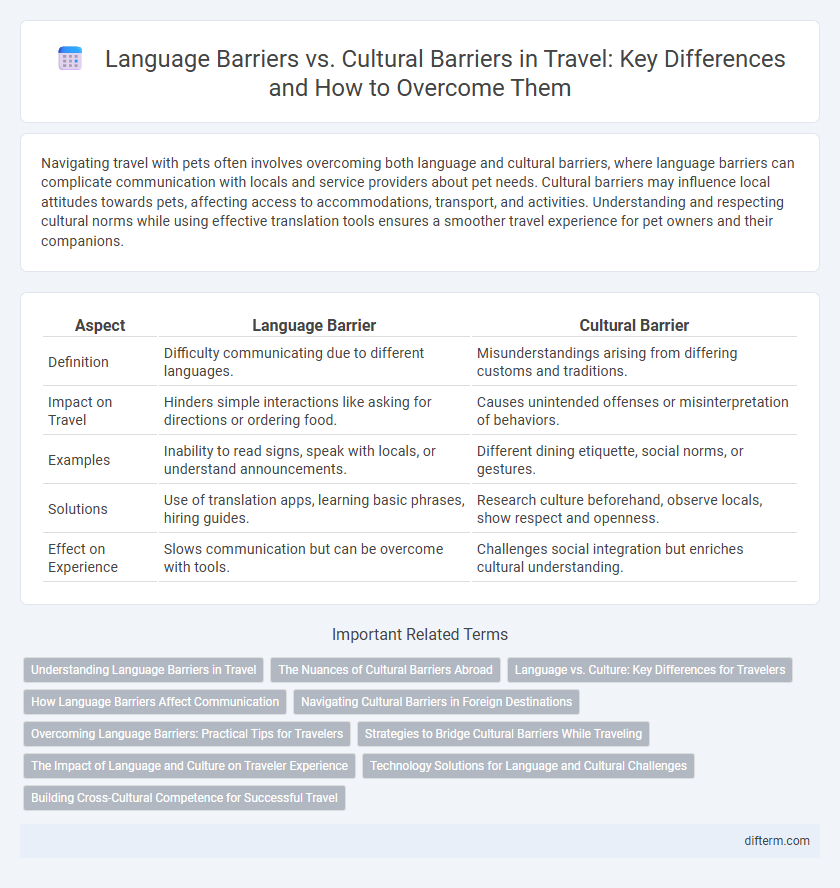Navigating travel with pets often involves overcoming both language and cultural barriers, where language barriers can complicate communication with locals and service providers about pet needs. Cultural barriers may influence local attitudes towards pets, affecting access to accommodations, transport, and activities. Understanding and respecting cultural norms while using effective translation tools ensures a smoother travel experience for pet owners and their companions.
Table of Comparison
| Aspect | Language Barrier | Cultural Barrier |
|---|---|---|
| Definition | Difficulty communicating due to different languages. | Misunderstandings arising from differing customs and traditions. |
| Impact on Travel | Hinders simple interactions like asking for directions or ordering food. | Causes unintended offenses or misinterpretation of behaviors. |
| Examples | Inability to read signs, speak with locals, or understand announcements. | Different dining etiquette, social norms, or gestures. |
| Solutions | Use of translation apps, learning basic phrases, hiring guides. | Research culture beforehand, observe locals, show respect and openness. |
| Effect on Experience | Slows communication but can be overcome with tools. | Challenges social integration but enriches cultural understanding. |
Understanding Language Barriers in Travel
Language barriers in travel challenge effective communication, often leading to misunderstandings and difficulty in navigating local services. Tourists encountering unfamiliar alphabets, accents, and idiomatic expressions may struggle to convey needs or comprehend directions, impacting their overall experience. Understanding these barriers emphasizes the importance of basic language preparation and non-verbal communication skills to enhance interaction and cultural immersion.
The Nuances of Cultural Barriers Abroad
Cultural barriers abroad extend beyond language differences, encompassing diverse social norms, customs, and non-verbal communication that travelers often overlook. Misinterpreting gestures, etiquette, or traditions can create misunderstandings despite language proficiency. Navigating these nuances requires cultural awareness and sensitivity to foster meaningful interactions and respectful experiences in foreign environments.
Language vs. Culture: Key Differences for Travelers
Language barriers involve difficulties in communication due to differences in spoken or written language, while cultural barriers stem from contrasting social norms, values, and behaviors unfamiliar to travelers. Effective navigation of language barriers often requires translation tools or basic vocabulary acquisition, whereas overcoming cultural barriers demands cultural awareness and adaptability to local customs. Recognizing these distinctions helps travelers enhance interactions, avoid misunderstandings, and enrich their travel experiences.
How Language Barriers Affect Communication
Language barriers hinder effective communication by causing misunderstandings and misinterpretations between travelers and locals. Mispronunciations, limited vocabulary, and differences in dialects often lead to confusion and frustration, impacting the overall travel experience. Overcoming language barriers requires using translation apps, non-verbal cues, and patience to foster clearer interactions and cultural exchange.
Navigating Cultural Barriers in Foreign Destinations
Navigating cultural barriers in foreign destinations requires understanding local customs, social norms, and etiquette to build respectful interactions and avoid misunderstandings. Unlike language barriers that can be addressed with translation tools and basic phrases, cultural barriers demand deeper awareness of values, traditions, and nonverbal communication specific to the region. Mastering cultural sensitivity enhances travel experiences, fosters meaningful connections, and prevents unintentional offenses in diverse international settings.
Overcoming Language Barriers: Practical Tips for Travelers
Mastering key phrases in the local language and using translation apps significantly reduce communication challenges for travelers. Non-verbal cues such as gestures and facial expressions play a vital role in bridging language gaps while respecting cultural norms. Patience and active listening enhance mutual understanding and foster positive interactions despite language differences.
Strategies to Bridge Cultural Barriers While Traveling
Effective strategies to bridge cultural barriers while traveling include learning key phrases of the local language to show respect and facilitate basic communication. Immersing oneself in local customs and traditions enhances cultural understanding and minimizes misunderstandings. Utilizing non-verbal communication, such as gestures and body language, helps overcome language barriers and fosters meaningful interactions with local communities.
The Impact of Language and Culture on Traveler Experience
Language barriers often lead to misunderstandings and frustration, significantly affecting a traveler's ability to navigate new environments and access services. Cultural barriers, including differing social norms and behaviors, influence how travelers interpret local customs and interact with residents, shaping overall satisfaction and safety. The combined impact of language and cultural differences highlights the importance of cultural competence and language preparation in enhancing the traveler experience.
Technology Solutions for Language and Cultural Challenges
Technology solutions such as AI-powered translation apps and real-time speech recognition devices drastically reduce language barriers by enabling seamless communication between travelers and locals. Virtual reality cultural training platforms enhance cultural understanding by immersing users in authentic scenarios, promoting respectful interaction across diverse customs and traditions. Integrated platforms combining geo-location data with contextual language and cultural cues support travelers in navigating unfamiliar environments confidently and respectfully.
Building Cross-Cultural Competence for Successful Travel
Mastering cross-cultural competence reduces the impact of language barriers by enhancing non-verbal communication skills and cultural awareness during travel. Understanding local customs, gestures, and social norms fosters meaningful interactions and minimizes misunderstandings. Prioritizing cultural sensitivity ensures successful navigation of diverse environments, enriching the overall travel experience.
language barrier vs cultural barrier Infographic

 difterm.com
difterm.com